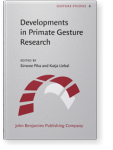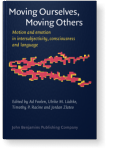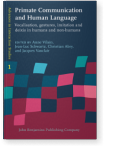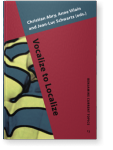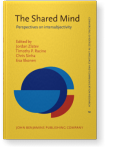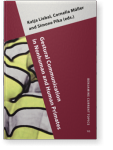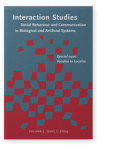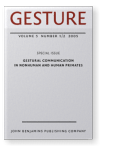David A. Leavens
List of John Benjamins publications for which David A. Leavens plays a role.
2012 Pointing: Contexts and instrumentality Developments in Primate Gesture Research, Pika, Simone and Katja Liebal (eds.), pp. 181–198 | Article
Although long heralded as a human species-unique gesture, pointing has now been demonstrated in numerous species of non-human animals. Many contemporary researchers argue that pointing for instrumental ends marks a different kind of psychological process from pointing to share attention as an end… read more
2012 Primates, motion and emotion: To what extent nonhuman primates are intersubjective and why Moving Ourselves, Moving Others: Motion and emotion in intersubjectivity, consciousness and language, Foolen, Ad, Ulrike M. Lüdtke, Timothy P. Racine and Jordan Zlatev (eds.), pp. 221–242 | Article
Focussing on the capacity for joint attention and communication, we review research that demonstrates the important and often overlooked role that emotion and motion may play in intersubjectivity and consciousness of self and others. We discuss the source of the continuing belief that such skills… read more
2011 Do chimpanzees have voluntary control of their facial expressions and vocalizations? Primate Communication and Human Language: Vocalisation, gestures, imitation and deixis in humans and non-humans, Vilain, Anne, Jean-Luc Schwartz, Christian Abry and Jacques Vauclair (eds.), pp. 71–88 | Article
It has been argued that only humans have volitional control of their vocalizations and that this ability allowed for the evolution of speech. Here we argue that recent studies in chimpanzees suggest that they do, in fact have some degree of voluntary control of both their vocalizations as well as… read more
2009 Manual deixis in apes and humans Vocalize to Localize, Abry, Christian, Anne Vilain and Jean-Luc Schwartz (eds.), pp. 67–86 | Article
2008 9. The heterochronic origins of explicit reference The Shared Mind: Perspectives on intersubjectivity, Zlatev, Jordan, Timothy P. Racine, Chris Sinha and Esa Itkonen (eds.), pp. 187–214 | Article
Explicit reference is the communicative capacity to intentionally pick out a specific object in the environment and make that object a manifest topic for shared attention. Pointing is the quintessential example of non-verbal, explicit reference. Chimpanzees, and other apes in captivity,… read more
2007 Multimodal concomitants of manual gesture by chimpanzees (Pan troglodytes): Influence of food size and distance Gestural Communication in Nonhuman and Human Primates, Liebal, Katja, Cornelia Müller and Simone Pika (eds.), pp. 67–80 | Article
It is well-established that chimpanzees vocalize more in the presence of relatively large amounts of food. The present study administered four trials in random order to each of 20 chimpanzees: (1) small piece of fruit, placed near to cage (~30 cm.), (2) large piece of fruit, placed near to cage,… read more
2005 Manual deixis in apes and humans Vocalize to Localize, Abry, Christian, Anne Vilain and Jean-Luc Schwartz (eds.), pp. 387–408 | Article
Pointing by apes is near-ubiquitous in captivity, yet rare in their natural habitats. This has implications for understanding both the ontogeny and heritability of pointing, conceived as a behavioral phenotype. The data suggest that the cognitive capacity for manual deixis was possessed by the last… read more
2005 Multimodal concomitants of manual gesture by chimpanzees (Pan troglodytes): Influence of food size and distance Gestural Communication in Nonhuman and Human Primates, Liebal, Katja, Cornelia Müller and Simone Pika (eds.), pp. 75–90 | Article
It is well-established that chimpanzees vocalize more in the presence of relatively large amounts of food. The present study administered four trials in random order to each of 20 chimpanzees: (1) small piece of fruit, placed near to cage (~30 cm.), (2) large piece of fruit, placed near to cage,… read more
